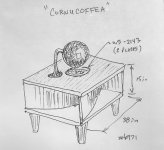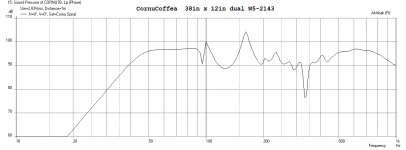Hi,
I got a pair of W5-1611SAF, 5 inch drivers and am looking for a enclosure and came across this forum and now I have so many enclosures to try 🙂
Reading the posts, it looks like I have to build a 36 X 36 spiral about 5 inches deep?
Can I make it a about 7 inches deeper and reduce the spiral size to say 30 X 30 or lesser?
thanks
I got a pair of W5-1611SAF, 5 inch drivers and am looking for a enclosure and came across this forum and now I have so many enclosures to try 🙂
Reading the posts, it looks like I have to build a 36 X 36 spiral about 5 inches deep?
Can I make it a about 7 inches deeper and reduce the spiral size to say 30 X 30 or lesser?
thanks
Hi,
Can I make it a about 7 inches deeper and reduce the spiral size to say 30 X 30
If you wanted to make the design deeper, you could make each horn channel narrower by the same ratio.
The area of each horn channel would be the same, but they'd complete more laps around the centre, thus allowing a longer horn path in a square truncated to 30'
Hi Guys, Sorry for the delays - unfortunately I'm not quite fit yet. I'm still a bit weak on my feet and I do not feel like doing anything but lying on the sofa and listening to music ... ... but it goes on slowly. After some minor preparatory Work I start now with the horn courses ("The Snail"). Below are a few Pictures of the Snails that have just been put to test (not yet glued) - as they will look like later. The rest of the pictures are self explanatory. LG D.W.
Attachments
-
 Back Plate (total).JPG38.2 KB · Views: 529
Back Plate (total).JPG38.2 KB · Views: 529 -
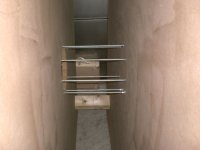 Speaker Rods.JPG49.9 KB · Views: 254
Speaker Rods.JPG49.9 KB · Views: 254 -
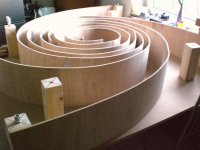 Snail unglued II (total).JPG90.2 KB · Views: 287
Snail unglued II (total).JPG90.2 KB · Views: 287 -
 Snail unglued I.JPG97.5 KB · Views: 259
Snail unglued I.JPG97.5 KB · Views: 259 -
 Side View w.o. Snail.JPG41.9 KB · Views: 199
Side View w.o. Snail.JPG41.9 KB · Views: 199 -
 Parallel Plates.JPG49 KB · Views: 500
Parallel Plates.JPG49 KB · Views: 500 -
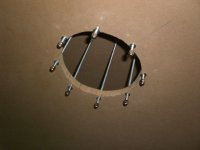 Front Plate Speaker Mounting.JPG49.5 KB · Views: 489
Front Plate Speaker Mounting.JPG49.5 KB · Views: 489 -
 Distance Block.JPG34.4 KB · Views: 528
Distance Block.JPG34.4 KB · Views: 528 -
 Back Plate Speaker Rods.JPG37.2 KB · Views: 533
Back Plate Speaker Rods.JPG37.2 KB · Views: 533
I have also been considering a bolt together assembly as opposed to the "you only get one chance" glue approach. Please let us know any ups / downs of this and if you are glad you did it instead of permanent glue.
Hi Guys,
@ Colingreen:
Due to the high weights and the resulting shear Forces, this question does not arise for me at all. At a certain Point in the Construction of such massive Objects you have to build uncompromising.
I insert the eight M16 threaded Rods to
1. to generate the necessary contact Pressure for the Glue (with the help of eight M8 threaded Rods)
2. to stabilize and stiffen the whole Part by pressing Pressure
3. to create a stable Suspension Point.
4. The M16 threaded Rods should also serve as a Backup if the Adhesive Joints fail and the part of the wall want to fall ...
5. ...
The total adhesive Surface is about 2800 cm² per plate. The minimum required pressing Pressure for this Area is 43 kN (4.3 tons).
One should not rely on the adhesive Force of the Glue in this part alone. At least I would not do it - hence the thick threaded Rods.
D.W.
@ Colingreen:
Due to the high weights and the resulting shear Forces, this question does not arise for me at all. At a certain Point in the Construction of such massive Objects you have to build uncompromising.
I insert the eight M16 threaded Rods to
1. to generate the necessary contact Pressure for the Glue (with the help of eight M8 threaded Rods)
2. to stabilize and stiffen the whole Part by pressing Pressure
3. to create a stable Suspension Point.
4. The M16 threaded Rods should also serve as a Backup if the Adhesive Joints fail and the part of the wall want to fall ...
5. ...
The total adhesive Surface is about 2800 cm² per plate. The minimum required pressing Pressure for this Area is 43 kN (4.3 tons).
One should not rely on the adhesive Force of the Glue in this part alone. At least I would not do it - hence the thick threaded Rods.
D.W.
Geez...
Today times all the stuff provisionally screwed together (still nothing is glued!) And a chassis connected. Amplifier and an old laptop on it and run some music:
OH MY GOD...
My face, that's going to be a wrecking Ball !
Despite the fact that the horn is too mismatched - the wall is missing, a chassis is missing, a horn mouth opening is totally closed and the whole thing is still leaking - surprisingly very clean bass came out. Powerful and deeper than the Titanic ...
And completely horn typical as well as sneaky.
Purely heard it goes to well below 30 hertz with little level drop, only below 25 hertz, it can then be ...
Speaking of level: 2.8 volts at 32 hertz (measured on the chassis) have made the whole room shake, tools are rattled from the workbench and everything that was not fixed has moved ... And then this incredible pressure in the room, crazy ,
The membrane of the chassis did not move visibly.
Music was very well contoured and clean, without much resonance. But, as seen in the Simu, 70 Hertz is over - here is a fat peak to hear. Anyway, I wanted to separate at about 45-50 Hz steeply anyway, so this peak is irrelevant.
The next few days come in a few additional threaded rods and then the whole Monster is properly glued. Just 5 kilos of glue are available for that.
D.W.
Today times all the stuff provisionally screwed together (still nothing is glued!) And a chassis connected. Amplifier and an old laptop on it and run some music:
OH MY GOD...
My face, that's going to be a wrecking Ball !
Despite the fact that the horn is too mismatched - the wall is missing, a chassis is missing, a horn mouth opening is totally closed and the whole thing is still leaking - surprisingly very clean bass came out. Powerful and deeper than the Titanic ...
And completely horn typical as well as sneaky.
Purely heard it goes to well below 30 hertz with little level drop, only below 25 hertz, it can then be ...
Speaking of level: 2.8 volts at 32 hertz (measured on the chassis) have made the whole room shake, tools are rattled from the workbench and everything that was not fixed has moved ... And then this incredible pressure in the room, crazy ,
The membrane of the chassis did not move visibly.
Music was very well contoured and clean, without much resonance. But, as seen in the Simu, 70 Hertz is over - here is a fat peak to hear. Anyway, I wanted to separate at about 45-50 Hz steeply anyway, so this peak is irrelevant.
The next few days come in a few additional threaded rods and then the whole Monster is properly glued. Just 5 kilos of glue are available for that.
D.W.
Cheers Mates 
I've heard a little bit of music about the still totally unfinished horn and I can say: I like it very much. If the characteristic does not change significantly then it fits quite well with my Fostex broadband backloaded horns (FE206en with additional Magnets)
D.W.

I've heard a little bit of music about the still totally unfinished horn and I can say: I like it very much. If the characteristic does not change significantly then it fits quite well with my Fostex broadband backloaded horns (FE206en with additional Magnets)
D.W.
I was going to put some kind of silicone caulking on the surfaces which touch instead of glue. Just a thin layer to try to seal. This would mainly be on the top and bottom edges of the waveguides and touch the front and back panel.
@ colinegreen:
If I finally grind the horn in the next few days, then I use a special industrial glue, which not only extremely strong, but also slightly foams.
So I'm not worried about leaks.
If I finally grind the horn in the next few days, then I use a special industrial glue, which not only extremely strong, but also slightly foams.
So I'm not worried about leaks.
Interesting - I was going to run my horn / waveguides assembly through a gigantic belt sander at a shop to make it flat and uniform thickness. Do you plan the same?
I was not going to glue at all, but just use bolts to clamp it, and silicone on the tops of the horns to minimize leaks.
Thoughts?
I was not going to glue at all, but just use bolts to clamp it, and silicone on the tops of the horns to minimize leaks.
Thoughts?
Hi Guys,
@ colinegreen:
The bending Plywood of my Horn courses is very precisely cut - the Gaps are less than 1mm - so I can press and glue them well.
In addition, 32 threaded Rods M8 (8mm) and 8 threaded Rods M16 (16mm)are used for pressing.
The remainder of Tolerances is bridged by the Adhesive.
Because of the heavy Weight (more than 200kg) I would like to glue the whole Horn as a solid Block, also to be able to sleep more peacefully at Night.
Because if this Monster falls off the Wall, there is an Earthquake in China ...
D.W.
@ colinegreen:
The bending Plywood of my Horn courses is very precisely cut - the Gaps are less than 1mm - so I can press and glue them well.
In addition, 32 threaded Rods M8 (8mm) and 8 threaded Rods M16 (16mm)are used for pressing.
The remainder of Tolerances is bridged by the Adhesive.
Because of the heavy Weight (more than 200kg) I would like to glue the whole Horn as a solid Block, also to be able to sleep more peacefully at Night.
Because if this Monster falls off the Wall, there is an Earthquake in China ...
D.W.
Just out of curiosity, how would it work if you skipped the back plate and instead installed adhesive insulating foam liner and then mounted the whole thing directly to the wall with bolts (or very long screws)? 🙂
Cheers !
@ silasmellor:
It would work just like a Backplate.
The Problem would be the not straight and uneven Wall. The resulting gaps would have to be closed with sealant. Unfortunately, these Sealants are elastic and let the Horn Guides resonate.
Therefore, I glue them with a special Polyurethane Adhesive, which foams slightly on curing and the rest Sealing Columns, so that there is absolutely nothing left to move.
My Construction with a Back Plate has the Advantage of very small Gaps, so that I make the whole Structure into one Stick solid Block and close tight. This was simply safer given the mass and the resulting Forces.
D.W.
@ silasmellor:
It would work just like a Backplate.
The Problem would be the not straight and uneven Wall. The resulting gaps would have to be closed with sealant. Unfortunately, these Sealants are elastic and let the Horn Guides resonate.
Therefore, I glue them with a special Polyurethane Adhesive, which foams slightly on curing and the rest Sealing Columns, so that there is absolutely nothing left to move.
My Construction with a Back Plate has the Advantage of very small Gaps, so that I make the whole Structure into one Stick solid Block and close tight. This was simply safer given the mass and the resulting Forces.
D.W.
ConuCoffea
I was thinking the spiral horn when large and sturdy could be made to be, say a large coffee table sub woofer with front radiator pointing down at floor and elevated several inches with feet. The horn mouths would be along the periphery and the top could even be thick glass bonded onto the channels with PL premium or maybe silicone caulking and extra bolts through L channel clamps along edge. Needs to be thick tempered glass like for commercial doors. That would be a neat statement sub for your room. If made of wood on top could have two opposed bipole drivers for force canceling effect. Need a grill over exposed top driver. Or make drivers full range with a suspended sphere Omni reflector. That would be a neat speaker. Uses a 1.5way crossover with simple coil for bottom driver. Two W5-2143’s would be perfect for this and has some nice top end. About 38in along an edge and 15in deep. Maybe 5in legs puts height at 20in for coffee table. Suspended sphere wound be say 8in dia and 3in above table top. Having bipole eliminates baffle step loss. Horn has 10dB bass gain. Two drivers in parallel add 6dB so 96dB sensitive speakers with extra 10dB bass to work with.
Maybe an omni supertweeter on top of sphere?
I was thinking the spiral horn when large and sturdy could be made to be, say a large coffee table sub woofer with front radiator pointing down at floor and elevated several inches with feet. The horn mouths would be along the periphery and the top could even be thick glass bonded onto the channels with PL premium or maybe silicone caulking and extra bolts through L channel clamps along edge. Needs to be thick tempered glass like for commercial doors. That would be a neat statement sub for your room. If made of wood on top could have two opposed bipole drivers for force canceling effect. Need a grill over exposed top driver. Or make drivers full range with a suspended sphere Omni reflector. That would be a neat speaker. Uses a 1.5way crossover with simple coil for bottom driver. Two W5-2143’s would be perfect for this and has some nice top end. About 38in along an edge and 15in deep. Maybe 5in legs puts height at 20in for coffee table. Suspended sphere wound be say 8in dia and 3in above table top. Having bipole eliminates baffle step loss. Horn has 10dB bass gain. Two drivers in parallel add 6dB so 96dB sensitive speakers with extra 10dB bass to work with.
Maybe an omni supertweeter on top of sphere?
Attachments
Last edited:
CornuCofffea sims better as 38in x 12in deep. As predicted, sensitivity is 97dB/2.83v and F10 is about 39Hz (usng 7mH 2ohm DCR choke on second driver):
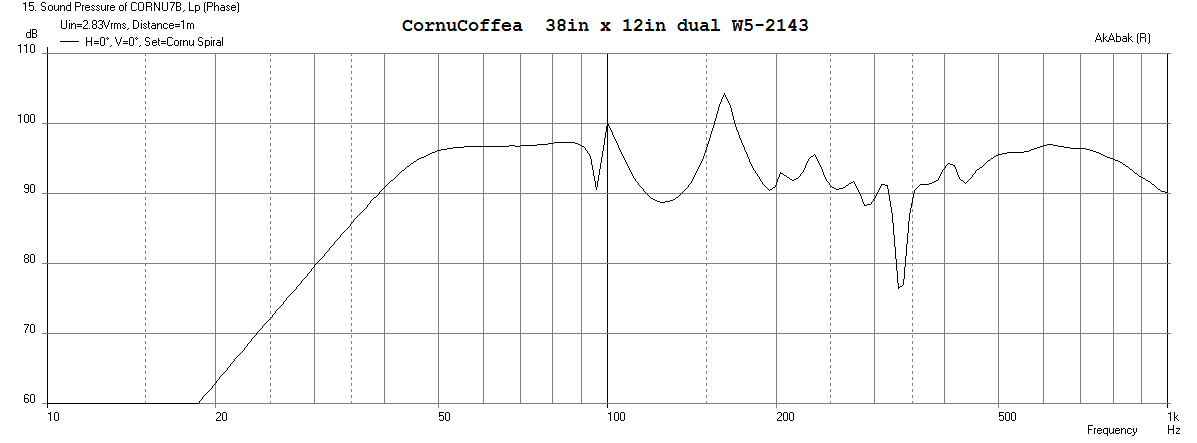
Attachments
Last edited:
- Home
- Loudspeakers
- Full Range
- Ever think of building a Cornu Spiral horn? Now you can!
